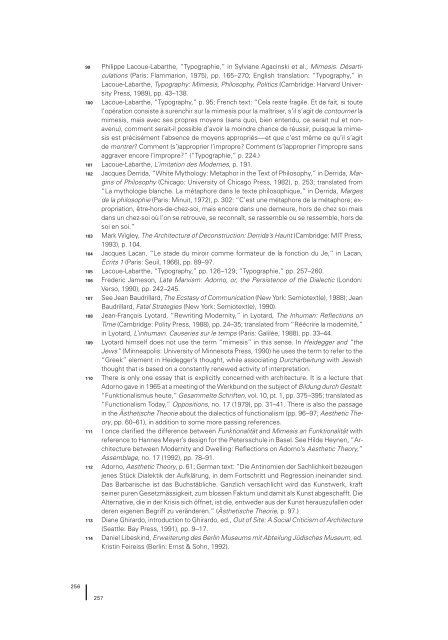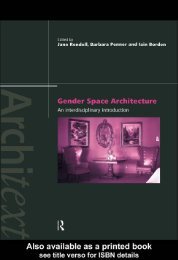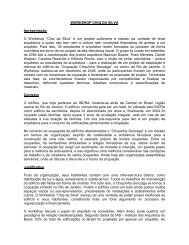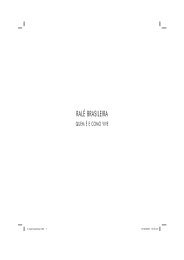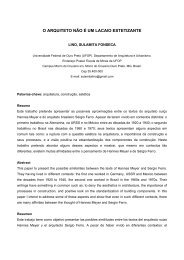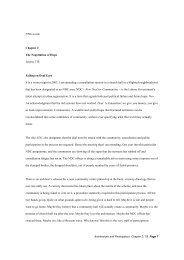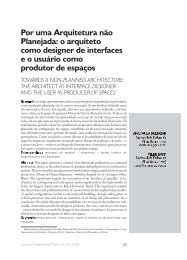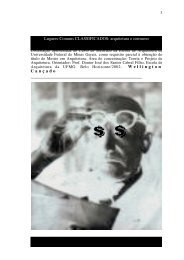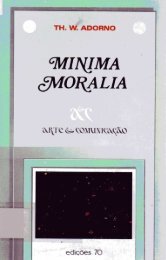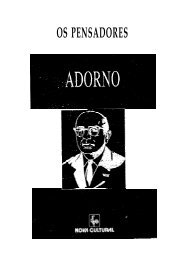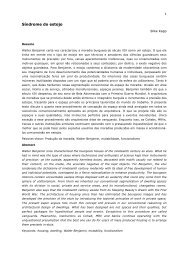Architecture and Modernity : A Critique
Architecture and Modernity : A Critique
Architecture and Modernity : A Critique
You also want an ePaper? Increase the reach of your titles
YUMPU automatically turns print PDFs into web optimized ePapers that Google loves.
256<br />
99 Philippe Lacoue-Labarthe, “Typographie,” in Sylviane Agacinski et al., Mimesis. Désarticulations<br />
(Paris: Flammarion, 1975), pp. 165–270; English translation: “Typography,” in<br />
Lacoue-Labarthe, Typography: Mimesis, Philosophy, Politics (Cambridge: Harvard University<br />
Press, 1989), pp. 43–138.<br />
100 Lacoue-Labarthe, “Typography,” p. 95; French text: “Cela reste fragile. Et de fait, si toute<br />
l’opération consiste à surenchir sur la mimesis pour la maîtriser, s’il s’agit de contourner la<br />
mimesis, mais avec ses propres moyens (sans quoi, bien entendu, ce serait nul et nonavenu),<br />
comment serait-il possible d’avoir la moindre chance de réussir, puisque la mimesis<br />
est précisément l’absence de moyens appropriés—et que c’est même ce qu’il s’agit<br />
de montrer? Comment (s’)approprier l’impropre? Comment (s’)approprier l’impropre sans<br />
aggraver encore l’impropre?” (“Typographie,” p. 224.)<br />
101 Lacoue-Labarthe, L’imitation des Modernes, p. 191.<br />
102 Jacques Derrida, “White Mythology: Metaphor in the Text of Philosophy,” in Derrida, Margins<br />
of Philosophy (Chicago: University of Chicago Press, 1982), p. 253; translated from<br />
“La mythologie blanche. La métaphore dans le texte philosophique,” in Derrida, Marges<br />
de la philosophie (Paris: Minuit, 1972), p. 302: “C’est une métaphore de la métaphore; expropriation,<br />
être-hors-de-chez-soi, mais encore dans une demeure, hors de chez soi mais<br />
dans un chez-soi où l’on se retrouve, se reconnaît, se rassemble ou se ressemble, hors de<br />
soi en soi.”<br />
103 Mark Wigley, The <strong>Architecture</strong> of Deconstruction: Derrida’s Haunt (Cambridge: MIT Press,<br />
1993), p. 104.<br />
104 Jacques Lacan, “Le stade du miroir comme formateur de la fonction du Je,” in Lacan,<br />
Ecrits 1 (Paris: Seuil, 1966), pp. 89–97.<br />
105 Lacoue-Labarthe, “Typography,” pp. 126–129; “Typographie,” pp. 257–260.<br />
106 Frederic Jameson, Late Marxism: Adorno, or, the Persistence of the Dialectic (London:<br />
Verso, 1990), pp. 242–245.<br />
107 See Jean Baudrillard, The Ecstasy of Communication (New York: Semiotext(e), 1988); Jean<br />
Baudrillard, Fatal Strategies (New York: Semiotext(e), 1990).<br />
108 Jean-François Lyotard, “Rewriting <strong>Modernity</strong>,” in Lyotard, The Inhuman: Reflections on<br />
Time (Cambridge: Polity Press, 1988), pp. 24–35; translated from “Réécrire la modernité,”<br />
in Lyotard, L’inhumain. Causeries sur le temps (Paris: Galilée, 1988), pp. 33–44.<br />
109 Lyotard himself does not use the term “mimesis” in this sense. In Heidegger <strong>and</strong> “the<br />
Jews” (Minneapolis: University of Minnesota Press, 1990) he uses the term to refer to the<br />
“Greek” element in Heidegger’s thought, while associating Durcharbeitung with Jewish<br />
thought that is based on a constantly renewed activity of interpretation.<br />
110 There is only one essay that is explicitly concerned with architecture. It is a lecture that<br />
Adorno gave in 1965 at a meeting of the Werkbund on the subject of Bildung durch Gestalt:<br />
“Funktionalismus heute,” Gesammelte Schriften, vol. 10, pt. 1, pp. 375–395; translated as<br />
“Functionalism Today,” Oppositions, no. 17 (1979), pp. 31–41. There is also the passage<br />
in the Ästhetische Theorie about the dialectics of functionalism (pp. 96–97; Aesthetic Theory,<br />
pp. 60–61), in addition to some more passing references.<br />
111 I once clarified the difference between Funktionalität <strong>and</strong> Mimesis an Funktionalität with<br />
reference to Hannes Meyer’s design for the Petersschule in Basel. See Hilde Heynen, “<strong>Architecture</strong><br />
between <strong>Modernity</strong> <strong>and</strong> Dwelling: Reflections on Adorno’s Aesthetic Theory,”<br />
Assemblage, no. 17 (1992), pp. 78–91.<br />
112 Adorno, Aesthetic Theory, p. 61; German text: “Die Antinomien der Sachlichkeit bezeugen<br />
jenes Stück Dialektik der Aufklärung, in dem Fortschritt und Regression inein<strong>and</strong>er sind.<br />
Das Barbarische ist das Buchstäbliche. Ganzlich versachlicht wird das Kunstwerk, kraft<br />
seiner puren Gesetzmässigkeit, zum blossen Faktum und damit als Kunst abgeschafft. Die<br />
Alternative, die in der Krisis sich öffnet, ist die, entweder aus der Kunst herauszufallen oder<br />
deren eigenen Begriff zu veränderen.” (Ästhetische Theorie, p. 97.)<br />
113 Diane Ghirardo, introduction to Ghirardo, ed., Out of Site: A Social Criticism of <strong>Architecture</strong><br />
(Seattle: Bay Press, 1991), pp. 9–17.<br />
114 Daniel Libeskind, Erweiterung des Berlin Museums mit Abteilung Jüdisches Museum, ed.<br />
Kristin Feireiss (Berlin: Ernst & Sohn, 1992).<br />
257


